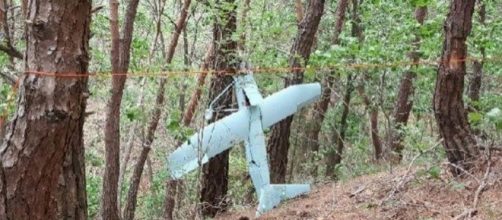North Korea had dispatched a Drone to spy over the Terminal High Altitude Area Defense Thaad installation in South Korea but it crashed when its fuel ran out. Its remains have now been recovered and preliminary investigations point to the fact that it was installed with a powerful digital camera. It had captured images of the THAAD installation that had been taken from a very high altitude of nearly 2-3 kilometers. Many of the images were still inside the camera which confirms that the drone was on a spy mission.
Worries for South Korea
CNN reports that the crashed drone of North Korea was probably deployed by Pyongyang as a part of its espionage activities and was meant to keep a close watch on THAAD, the controversial US-built missile system that is being deployed in South Korea.
The drone probably crashed after it ran out of fuel.
Some of the aerial shots captured by the digital camera were of the THAAD system located more than 100 miles away from the border. This system is designed to shoot down missiles of North Korea that are headed to South Korea before they can do any damage.
The drone is presumed to be from Pyongyang since it is similar to a North Korean drone that had crashed in 2014 on a nearby island and another one in the city of Paju. This city is located in the demilitarized zone between the two countries and is one of the most heavily militarized and monitored places on the planet with tight security measures in place to detect unwanted movements. In view of the turbulent situation in the region, anything out of the way is suspect.
Controversy surrounding THAAD
The United States gave the THAAD system to South Korea for its own safety but a controversy has now arisen. The decision to have the system was taken by the previous regime of President Park Geun-hye, who has, since, been impeached and removed from power. The decision had been objected to by China who felt that it could pry into its defense installations.
North Korea was also upset. In addition to the controversy, Moon Jae-in, the new president of South Korea, has put the deployment on hold citing environmental reasons.
It may be recalled that Moon Jae-in is a left-leaning leader and had promised in his campaign to put the final decision on deployment of the THAAD missile system before the country's parliament.
Moreover, businesses in South Korea anticipate problems in their dealings with China if THAAD stays. Accordingly, the matter has to wait until it gets a clearance from the authorities who have to assess the environmental impact.
Under the circumstances, there is a confusion over whether the missile defense system will finally be deployed. South Korea is a strategical ally of the United States and the change of guard in Seoul has changed the equation. The new president had expressed a desire to mend fences with North Korea and Washington may have to recast its strategies in the Korean peninsula.


